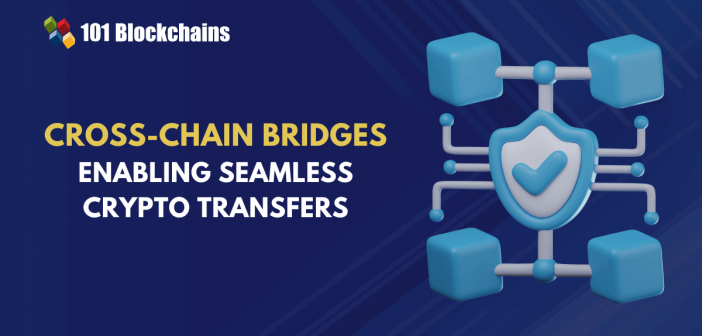Accelerate your crypto career with the world’s only accredited cryptocurrency certification, and master the skills that set you apart in the fast-evolving digital asset landscape.

- Cryptocurrency
Georgia Weston
- on April 23, 2025
How Cross-Chain Bridges Enable Seamless Crypto Transactions?
The blockchain realm has been a revolutionary form of innovation in the 21st century. However, the expanding acceptance as well as increasing popularity of blockchain has given rise to a plethora of blockchain networks. That’s true! Thus, it has led to the high fragmentation of the blockchain ecosystem, thereby giving rise to interoperability concerns. This is when cross-chain bridges come into the picture.
The emergence of cross-chain bridges has been a breath of fresh air for the entire blockchain community. Cross Chain Bridges in crypto facilitate composability across diverse blockchain networks. Let’s explore deeper to understand how cross-chain bridges support seamless crypto transactions.
Build your identity as a certified blockchain expert with 101 Blockchains’ Blockchain Certifications designed to provide enhanced career prospects.
A Glimpse into Cross-Chain Bridges
Cross Chain Bridges have come into existence as the perfect solution to address interoperability concerns in the crypto space. Cross Chain Bridges can be defined as the protocols that allow the transfer of data, information as well as assets between diverse blockchain networks. You can think of them as connecting agents that support two or more blockchains to engage and interact with each other. Hence, crypto bridges transactions are able to overcome the natural obstacles and bottlenecks that exist within individual blockchain ecosystems.
In the current time when the blockchain realm is booming and expanding like never before, the concept of cross chain bridges has been revolutionary. That’s correct! These bridges have led to the unlocking of a plethora of new possibilities. These new possibilities include better liquidity, a higher satisfaction level of users as well as a higher degree of decentralization.
Although the concept relating to Cross Chain Bridges in crypto are fairly new, they are full of promise. Within a short span of time, Cross Chain Bridges have successfully paved the way for a new blockchain era. If you are wondering how, the answer is quite straightforward. The emergence of cross-chain bridges has made it possible for isolated blockchain networks to work in a cohesive manner.
Core Mechanisms of Cross-Chain Bridges
Now that you have an insight into cross-chain bridges, you may be wondering, ‘What is a bridge transaction?’ It is very obvious to have this question in mind. However, in order to answer this question, you need to become familiar with the core mechanisms that are involved in cross-chain bridges. By looking at this area, you can understand how cross-chain bridges function, leading to bridge transactions.
-
Locking Assets of Users
When an individual wishes to transfer their asset from one blockchain network to another, the first step involves asset locking. The bridge locks the asset on the source blockchain. It implies that the asset is held securely as it is sent to a custodial wallet or a smart contract.
-
Creation of Wrapped Assets
In the next stage, Cross cross-chain bridges in crypto are responsible for issuing a corresponding asset. It is also known as a wrapped asset, and this asset is created on the destination blockchain network. The role of the specific asset is of cardinal importance. This is because it represents the value of the user’s original asset.
-
Facilitation of Cross-Chain Transfer
After the wrapped assets have come into existence in the destination chain, they are ready for cross-transfer. That’s right! They are transferred to the user’s wallet on the destination blockchains. Thus, the cross-chain transaction comes to an end.
-
Burning of the Wrapped Assets
In case the user wishes that their asset should return to the original blockchain, this is done by destroying the wrapped asset on the destination chain. After the process, the cross-chain bridge is responsible for unlocking the equivalent amount of the users’ original asset. Therefore, the user has the opportunity to reclaim their asset. The specific model that is adopted ensures that there exists proper consistency when it comes to the supply of the assets in both blockchains. Moreover, it helps prevent issues relating to double spending.
The underlying mechanism of cross-chain bridges serves as a catalyst and boosts interoperability. In order to maximize the benefits of these bridges, you may consider referring to the cross-chain crypto list. It can certainly help you strategically leverage cross-chain bridges and enjoy engaging in seamless crypto transactions.
Start learning Blockchain with World’s first Blockchain Career Paths with quality resources tailored by industry experts Now!
Bright future of cross-chain bridges
The future of Cross Chain Bridges is full of promise. It has emerged as a revolutionary solution that helps to improve interoperability in the crypto landscape by bridging the gap between individual blockchain networks. As the crypto realm expands at a rapid pace, the value of cross-chain bridges may further magnify and reach new heights in the future.
In the future, it is likely that the utility of cross-chain bridges crypto will further skyrocket. With the rising adoption of cryptocurrencies, more people will be willing to engage in crypto bridge transactions. Thus, they will be able to seamlessly transfer assets in the blockchain ecosystem without having to worry about its fragmented nature.
In the evolving and expanding crypto domain cross-chain bridges have the potential to support interoperability at the multi-chain level. By capitalizing on the underlying mechanics of cross-chain bridges in crypto, users will be able to engage in diverse assets and applications without any obstacles. Therefore, crypto bridge transactions can help you derive optimum value from crypto transactions.
Potential challenges to consider
In order to get a holistic insight into cross-chain bridges in crypto, it is a must to consider potential challenges that may arise in the path. Even though the future of cross-chain bridges is full of new possibilities, certain challenges may arise. Only by identifying the potential challenges is it possible to prepare oneself to leverage cross-chain bridges to the fullest.
-
Security-related concerns
One of the main challenges that may arise in the context of crypto bridge transactions revolves around security. That’s right! You cannot ignore the possibility of security-related concerns. As several interaction points exist between different blockchain networks, security may be breached by malicious actors. In case any vulnerability exists in the bridge, it may be exploited, leading to the compromise of the asset transfer process.
-
High cost
Another challenge for the users of crypto bridge transactions may arise in the form of high cost. Crypto bridge transactions may be much more expensive in comparison to other transactions that take place within individual blockchain networks. Thus, if you plan to make use of cross-chain bridges in crypto, you should be ready to bear additional transaction fees.
-
Poor degree of standardization
Although Cross cross-chain bridges have the potential to revolutionize the crypto landscape by redefining interoperability, a major obstacle may arise in the path. The obstacle is related to the absence of standardization. Due to poor standardization in terms of protocols, ambiguity may arise in the context of cross-chain bridges in crypto. It may undoubtedly diminish its potential and the value that users are able to derive from crypto bridges transactions.
-
Concerns relating to scalability
Another potential challenge revolves around scalability aspects. The rising popularity as well as acceptance of cross chain bridges in crypto may give rise to scalability issues. The issue may further intensify when the traffic is high. Thus, users may find it challenging to effectively transfer their assets from one blockchain network to another. If focus is not laid on improving the scalability feature of Cross Chain Bridges in the future, it may act as a major hinderance for users. This is because the overall performance as well as reliability of crypto bridges transactions may diminish.
-
Regulatory concerns
In the future, stringent and complex regulations may arise in the crypto realm. These regulations may increase the overall complications with regard to crypto bridges transactions. The lack of adherence to the necessary regulations and legislation may give rise to serious problems for diverse stakeholders that exist in the crypto space.
The challenges that have been identified need to be addressed in a strategic manner. Only by adopting a strategic approach will it be possible to optimally utilize cross-chain bridges in crypto and engage in seamless crypto transactions.
Start learning Blockchain with World’s first Blockchain Skill Paths with quality resources tailored by industry experts Now!
Final words
The introduction of cross-chain bridges has been a transformational force in the prevailing cryptocurrency realm. These bridges have created a unique pathway that can help in addressing the concerns relating to the interoperability aspect of blockchain. The crypto bridges transactions allow users to transfer assets between different blockchain networks.
As a result, it has become possible to overcome the issues concerning the fragmented nature of individual blockchains. In order to leverage cross-chain bridges in crypto to the fullest you need to understand its underlying mechanisms and associated challenges at a comprehensive level.
*Disclaimer: The article should not be taken as, and is not intended to provide any investment advice. Claims made in this article do not constitute investment advice and should not be taken as such. 101 Blockchains shall not be responsible for any loss sustained by any person who relies on this article. Do your own research!






